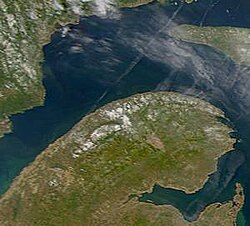Loading AI tools
Peninsula in Quebec, Canada From Wikipedia, the free encyclopedia
The Gaspé Peninsula, also known as Gaspesia[2] (French: Gaspésie, [ɡaspezi]; Mi'kmaq: Gespe'gewa'ki), is a peninsula along the south shore of the St. Lawrence River that extends from the Matapedia Valley in Quebec, Canada, into the Gulf of St. Lawrence. It is separated from New Brunswick on its southern side by Chaleur Bay and the Restigouche River. The name Gaspé comes from the Mi'kmaq word gespe'g, meaning "end", referring to the end of the land.[3]
Gaspé Peninsula | |
|---|---|
 NASA satellite image of the Gaspé Peninsula. Part of Anticosti Island appears to the northeast. | |
| Coordinates: 48°39′29″N 65°45′10″W | |
| Country | Canada |
| Province | Quebec |
| Area | |
| • Land | 31,075.36 km2 (11,998.26 sq mi) |
| Population (2011)[1] | |
| • Total | 140,599 |
| • Density | 4.5/km2 (12/sq mi) |
The Gaspé Peninsula is slightly larger than Belgium, at 31,075 square kilometres (11,998 sq mi).[4] The population is 140,599 as of the 2011 census.[5] It is also noted as the only region outside the Channel Islands to contain native speakers of Jersey Norman.[citation needed]
Sea cliffs dominate the peninsula's northern shore along the St. Lawrence River.[6] Cap Gaspé, jutting into the Gulf of St. Lawrence, is the easternmost point of the peninsula. Percé Rock (or Rocher Percé), an island pierced by a natural arch, is just offshore of the peninsula's eastern end. The peninsula's interior is a rugged northward continuation of the Appalachian Mountains called the Chic-Chocs, with Mount Jacques-Cartier at 1,268 metres (4,160 ft) the peninsula's highest peak.
Mount Albert (Mont Albert) at 1,151 m (3,776 ft)[7] is another high mountain in the Chic-Chocs. Its summit, an alpine area above the tree line, is a nearly flat plateau about 13 km (8 mi) across composed of serpentine bedrock and supporting quite unusual flora.[8] The ascent of Mount Albert from near sea level is challenging, but popular with hikers, offering a view of the St. Lawrence and the Côte-Nord, the river's north shore, part of the ancient bedrock of the Canadian Shield.
The interior portions of the peninsula are dominated by the Chic-Choc Mountains, part of the Notre Dame Mountains, an extension of the Appalachian Mountains.
The town of Murdochville, at about 660 metres (2,170 ft) above sea level, has had a varied history, and is now home to several wind turbines. It is reached by Route 198, which extends inland from the northern shore of the peninsula, soon climbing into the mountains and entering vast forests, crossing several small rivers before reaching the town. From Murdochville, Route 198 follows the York River to the city of Gaspé on the peninsula's eastern tip.
The peninsula's economy has historically been focused on fishing, agriculture and forestry. But primary resource-based industries are suffering due to overfishing, overexploitation, and fewer numbers of farmers in business, forcing the region to move towards tourism and the services industry.

The peninsula is one of Quebec's most popular tourism regions. The Gaspé National Park (Parc national de la Gaspésie) is in the Chic-Chocs, and Forillon National Park is at the peninsula's northeastern tip. A section of the International Appalachian Trail travels through the peninsula's mountains. Bonaventure National Park is here. As of September 2018 the area also hosts Canada's third UNESCO Global Geopark.

Seamless Wikipedia browsing. On steroids.
Every time you click a link to Wikipedia, Wiktionary or Wikiquote in your browser's search results, it will show the modern Wikiwand interface.
Wikiwand extension is a five stars, simple, with minimum permission required to keep your browsing private, safe and transparent.